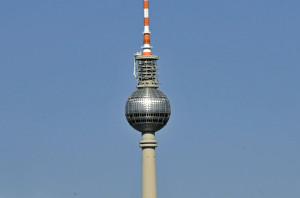The tower, called Fernsehturm in German, was designed a few years after the Soviet Union had beaten the United States into space with a spherically-shaped satellite named “Sputnik.” To trumpet that achievement, the concrete base of the tower was designed to suggest a rocket, with a sphere representing Sputnik near the apex. The massive sphere, with seven floors inside, was covered with 140 stainless steel panels, designed to gleam in the sunlight.
Even before the tower was completed in 1969, residents of Berlin noticed something the East German architects had never anticipated. Sunlight reflecting from the panels of the sphere created a nearly perfect Greek cross, visible throughout the divided city. West Berliners quickly dubbed this Christian symbol in a Communist country the “Pope’s Revenge,” divine retaliation for the government’s removal of crosses from East Berlin’s churches. An embarrassed government reportedly tried painting the tiles to eliminate the cross, without success.
When President Ronald Reagan spoke before Berlin’s Brandenburg Gate on June 12, 1987, demanding that Soviet Leader Mikhail Gorbechev “tear down this wall,” he spoke of the efforts to eliminate the unintended cross: “There in Berlin, like the city itself, symbols of love, symbols of worship, cannot be suppressed.” Twenty-nine months later, the Berlin Wall came down and Berlin was united. Today, Berlin’s tower attracts more than a million visitors a year, many eating in its revolving restaurant 680 feet above the street. On sunny days, Berlin guides point to the gleaming tower and its cross, proudly noting that other crosses have returned to their churches.
